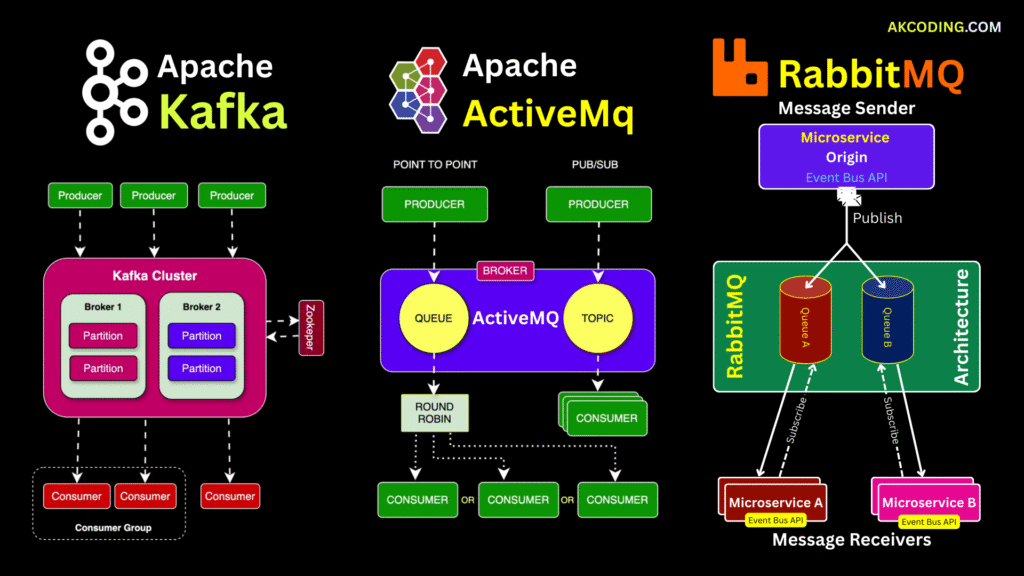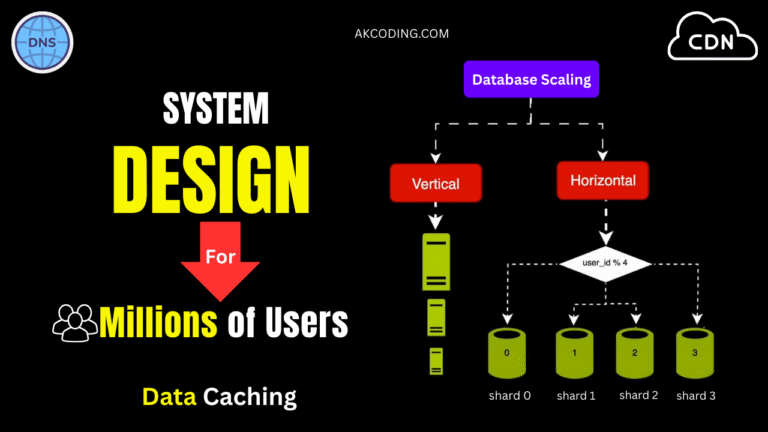Compare Kafka, RabbitMQ, and ActiveMQ to find the best message broker for your system. Explore key differences in performance, use cases, scalability, and architecture.

Hello Readers,
When you’re building systems that need to move data between services quickly and reliably, the importance of choosing the right message broker cannot be overstated. Message brokers act as the backbone of modern, distributed systems — whether you’re handling millions of streaming events per second or managing small, transactional workloads across microservices. They ensure that your services can talk to each other efficiently, decoupled from direct dependencies, and resiliently across network boundaries.
The decision you make here can influence every part of your architecture — from performance and latency to scalability, fault tolerance, system complexity, and even the ease of monitoring and maintenance.
Among the many options out there, Apache Kafka, RabbitMQ, and Apache ActiveMQ consistently emerge as industry favorites. Each of these tools has carved out a unique niche in the world of messaging and event-driven architecture:
- Kafka has become synonymous with real-time data streaming and analytics.
- RabbitMQ excels in reliable message delivery and intelligent routing.
- ActiveMQ remains a staple in enterprise-grade Java applications and JMS-based systems.
But here’s the catch: while all three handle messages, they’re built on very different philosophies. Kafka is an event log platform first, RabbitMQ is a traditional queue-based broker, and ActiveMQ plays the role of a protocol-flexible bridge between applications.
So how do you decide which one fits your use case best? Do you prioritize throughput, durability, or ease of setup? Do you need replayability or are you simply distributing tasks? Are you working in a Java ecosystem, or dealing with IoT protocols like MQTT?
In this article, we’re going to break down the core differences, strengths, and trade-offs between Kafka, RabbitMQ, and ActiveMQ — so that you can make an informed decision based on your specific needs, not just popular trends.
Let’s dive in.
📦 What Are These Tools, Really?
Before we start a head-to-head, it helps to know what each one is fundamentally built for:
- Apache Kafka is a distributed event streaming platform. It’s designed for high-throughput, real-time data pipelines and event-driven architecture.
- RabbitMQ is a traditional message broker that implements AMQP. It focuses on message queuing, routing, and delivery guarantees.
- ActiveMQ, from the Apache Foundation, is another powerful message broker, supporting multiple protocols including JMS, and is often seen in Java-heavy environments.
🧠 Architectural Philosophy
Kafka embraces a log-based architecture. Messages are written to an append-only log and retained for a configurable time — even after being read. This makes Kafka ideal for replayable, persistent event streams.
RabbitMQ and ActiveMQ, on the other hand, treat messaging more transiently — messages are consumed and removed from the queue, fitting more traditional pub-sub or work queue patterns.
⚙️ Core Use Cases

⚡ Performance & Throughput
Kafka is king of throughput. It’s designed to handle millions of messages per second with horizontal scalability. It achieves this through zero-copy IO, efficient batching, and partitioning.
RabbitMQ is fast, but its throughput is lower than Kafka’s, especially under high loads. It’s not meant for massive firehoses of data but rather complex routing and guaranteed delivery.
ActiveMQ is generally the slowest of the three in high-throughput scenarios but adequate for many enterprise use cases where throughput isn’t the bottleneck.
🔐 Reliability and Durability
- Kafka: Messages are persisted by default. Consumers can replay messages from any point.
- RabbitMQ: Messages can be persisted and acknowledged, but require more tuning to guarantee durability.
- ActiveMQ: Also supports persistence, but its broker-based model can be prone to performance hits under load.
If message durability and replay are important, Kafka wins. If at-most-once delivery is acceptable and speed matters, RabbitMQ may suffice.
🛠️ Operational Complexity
Kafka can be tricky to operate. You’ll need to manage brokers, Zookeeper (or KRaft), partitions, replication, and retention. But it scales like a beast.
RabbitMQ and ActiveMQ are easier to get started with and have mature UI tools for monitoring and managing queues.
💬 Protocol Support
- Kafka: Native Kafka protocol; clients in many languages.
- RabbitMQ: AMQP (1.0 and 0.9.1), MQTT, STOMP.
- ActiveMQ: JMS, AMQP, MQTT, STOMP, OpenWire.
If protocol flexibility matters (e.g., integrating with IoT or legacy systems), RabbitMQ and ActiveMQ offer more out-of-the-box.
🧩 Integration Ecosystem
- Kafka shines with tools like Kafka Streams, Kafka Connect, ksqlDB, and its rich ecosystem (e.g., Flink, Spark).
- RabbitMQ integrates well with most back-end services, frameworks, and languages, but has fewer native stream-processing tools.
- ActiveMQ fits best in Java ecosystems (especially those built around JMS).
✅ Quick Decision Table

💡 So… Which One Should You Use?
- Choose Kafka if:
- You need high throughput, event streaming, or data replay.
- You’re building real-time analytics, log aggregation, or microservices at scale.
- Choose RabbitMQ if:
- You need smart routing, easy retries, or inter-process communication.
- You’re working with short-lived tasks or simple message patterns.
- Choose ActiveMQ if:
- You’re in a Java-heavy enterprise with existing JMS-based systems.
- You want a mature, stable broker with broad protocol support.
🚀 Final Thoughts
There’s no one-size-fits-all in the world of message brokers. Kafka, RabbitMQ, and ActiveMQ all serve their purpose. The best choice depends not on which tool is “better,” but on what your system actually needs.
Start small. Know your traffic patterns. And don’t be afraid to mix and match tools if your architecture grows more complex.
Interview Questions
🔰 Beginner-Level Questions
- What is a message broker and why is it important in distributed systems?
- Can you briefly describe Apache Kafka, RabbitMQ, and ActiveMQ? What are they used for?
- What are the key differences between Kafka and RabbitMQ?
- Which messaging system would you choose for a real-time analytics pipeline, and why?
- How does Kafka differ from traditional message queues like RabbitMQ or ActiveMQ?
- What’s the difference between a queue and a topic in messaging systems?
⚙️ Intermediate-Level Questions
- Explain how Kafka ensures message durability and fault tolerance.
- In RabbitMQ, what are exchanges and how do they differ from queues?
- How does ActiveMQ integrate with Java-based applications? What is JMS?
- Compare the message delivery guarantees (at-most-once, at-least-once, exactly-once) among Kafka, RabbitMQ, and ActiveMQ.
- Which broker is better for high throughput scenarios, and why?
- What is the role of Zookeeper in Kafka, and how does it impact its operations?
- How does RabbitMQ handle backpressure and consumer overload?
- What are the pros and cons of using Kafka in a microservices architecture?
- What are the key architectural components of Kafka? How does partitioning work?
🧠 Advanced-Level / System Design Questions
- Design a system for processing millions of events per second. Would you use Kafka, RabbitMQ, or ActiveMQ? Justify your choice.
- How would you implement a retry mechanism for failed messages in RabbitMQ vs. Kafka?
- What are some scalability concerns you might face with RabbitMQ or ActiveMQ? How can they be addressed?
- Can you implement a message replay feature in RabbitMQ or ActiveMQ? Why or why not?
- How would you secure a Kafka cluster in production?
- When integrating multiple systems with different protocols (e.g., MQTT, AMQP), which broker is the most flexible? Why?
- What are the challenges in achieving exactly-once delivery semantics in Kafka?
- How would you monitor and scale a Kafka cluster to ensure minimal message loss during a spike in traffic?
- How does Kafka Streams differ from RabbitMQ consumers in terms of stream processing capabilities?
🚀 Bonus Practical Questions
- How would you migrate an existing RabbitMQ-based system to Kafka without downtime?
- Describe a failure scenario in a Kafka consumer group and how Kafka handles recovery.
- Have you ever configured dead-letter queues in RabbitMQ or ActiveMQ? How do they work?
- What’s your approach to ensuring message ordering in a distributed message broker system?
- What trade-offs would you consider when choosing between Kafka and RabbitMQ for an IoT application?
- What are the performance tuning parameters you’d look at when optimizing Kafka for low latency?
Read other awesome articles in Medium.com or in akcoding’s posts.
OR
Join us on YouTube Channel
OR Scan the QR Code to Directly open the Channel 👉




